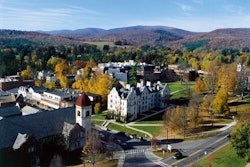 Duke students demanded action from administrators in April regarding the incident involving Executive Vice President Tallman Trask and parking employee Shelvia Underwood. (Photo courtesy Jesus Hidalgo and Guatam Haithi/The Chronicle)
Duke students demanded action from administrators in April regarding the incident involving Executive Vice President Tallman Trask and parking employee Shelvia Underwood. (Photo courtesy Jesus Hidalgo and Guatam Haithi/The Chronicle)Asian American students have been active participants and outspoken leaders in recent campus protests, including actions supporting the concerns of other racial groups.
Last month, about 80 students at The Ohio State University held a brief occupation of a campus administration building presenting a myriad list of demands including financial transparency. The event ended after about eight hours when administrators threatened expulsion and arrest. Several leaders of that aborted effort were Asian American students who have vowed to continue to press their demands. The university’s response was that it was “committed to all parties interested in meaningful discourse.”
Also in April, nine Duke University students staged a weeklong sit-in in support of an African-American parking employee, who has filed a lawsuit against a Duke administrator and the university, and on behalf of the university’s contract workers who are seeking reforms. Four of the nine protesters were of Asian descent, as were a number of the supporters camped out in front of the building.
Speaking out
“Asian Americans are American citizens and this [is] their country, too — they have been brought up as Americans, and this has taught them that they have a right to speak up and be heard just like all the non-Asian youth in our country,” says Dr. Zauyah Waite, vice president of student affairs and dean of students at Chatham University in Pittsburgh.
“Many people see an Asian American on their college campus speaking out and think that is not in line with how most Asians would react, [but] the reality is that these students were not brought up in the same culture as their parents or grandparents,” explains Waite, who is also a member of the board of NASPA ― Student Affairs Administrators in Higher Education.
In past years, and even recently, some Asian American activists and scholars have decried purported complacency toward social issues among their peers. Frank H. Wu, Distinguished Professor of Law and former chancellor and dean of the UC Hastings College of the Law, wrote in his 2001 book, Yellow: Race in America Beyond Black and White, “We’ve gotten too comfortable. Many Asian Americans tend to become involved only when something bad happens. It is crucial to build institutions, be proactive and start reaching out to others, build bridges to other groups. We need to give people a reason to believe in a cause.”
Maryam Abidi, a third-year Ohio State undergraduate who was among the administration building protesters, says she believes in building those bridges. The daughter of Pakistani parents, Abidi identifies as Asian American and says the sit-in “was an amazing mix,” with Latino, South Asian and Asian American, White, African-American and LGBT representatives joining forces.
“It felt so good to be in that kind of space. Solidarity across race, ethnicity and culture is the only way we can move forward and make change,” she says, adding that she has been involved in various social justice organizations including Black Lives Matter, and support groups for Ferguson protesters and University of Missouri students.
But last December, an article in The Atlantic criticized the absence of Asian Americans in recent campus protests at Ivy League institutions. Princeton assistant professor Kinohi Nishikawa was quoted as saying, “We remain silent and prop up a fundamentally unequal system at our own peril. At the expense of our continued minoritization. It is in our self-interest to speak out — we belong and they belong too. We are not tokens. We are ourselves self-determining people. We do a disservice to ourselves by not wanting to make waves.”
Natural progression
However, Nishikawa told Diverse via email that there may have been a natural progression. “Have these spring protests learned from student activism in the fall? Absolutely. But they are slightly different, too, in that they are, in spirit and organization, about building a broad-based coalition to tackle the structural inequalities of the 21st-century university.
“We can speculate that ‘more Asian Americans’ have joined, and indeed led, these protests, in part because building and sustaining coalitions has become the dominant mode of campus protest this spring. From this perspective, the fall semester’s hand-wringing over ‘the question of allyship’ has been replaced by doing the hard but necessary work of forging a movement of allies.”
But such criticisms don’t apply to those Asian American activists who are putting their academic careers on the line to stand up for their convictions. Christine Lee, a Duke sophomore who is part of the group leading the effort for an Asian American studies major, has helped to shape a campaign by three campus organizations that has presented demands to the administration for the major.
She also was involved in a support group for the nine students who occupied the building. After the one-week occupation, the students won a number of concessions from the administration regarding conditions and wages of contract workers. They had demanded increasing the minimum hourly wage to $12.53 and up to $15 by July 2019. The university issued a statement that it would “begin the process” of raising the wage above $12.
“Growing up in the South, I never really had much exposure to role models that looked like me, so, in high school, when I heard about Asian American activists like Yuri Kochiyama and Grace Lee Boggs, I got hooked,” Lee told Diverse via email. “By learning about these amazing women, I was able to think deeper about who I was without being hindered by the pervading narrative of what dominant society tells me I can and cannot be.”
Abidi says she, too, was influenced by “the writings of women of color — and the struggles of women of color.”
Dr. Pranav Jani, an associate professor in the Department of English at Ohio State, says, “People have gotten a kind of wake-up call because of racial targeting that has always been there but has become very explicit after 9/11, especially directed against Arabs and South Asians, whether they are Muslim or not. I think that’s created a certain oppositional consciousness — that you can’t just float into normal citizenship like everybody else.” Jani, who identifies as South Asian American, teaches postcolonial studies and U.S. ethnic studies.
According to a 2014 Pew Research Institute report, organizations representing people of Middle Eastern and North African descent were asking the Census Bureau to place a new ethnic category on its forms. “People of this heritage are now categorized as ‘White,’ a decades-old practice advocacy groups say is inaccurate,” the report stated. “The push to be counted as something other than white is a reversal from a century ago,” partly due to the early 20th century “anti-Asian legislation that sought to restrict immigration and deny Asians U.S. citizenship.”
Nishikawa asserts that the Duke and Ohio State demands have brought students of various backgrounds together for an important reason: “At their most capacious, these were protests against the structural inequalities that have become tolerable, if not endemic, to the management of the corporate university. I understand #DismantleDukePlantation and #ReclaimOSU to have made the best possible case for how institutional inequality affects everyone: students, faculty and staff.”















